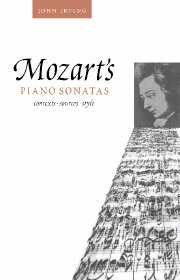Book contents
9 - Eighteenth-century views of sonata form
Published online by Cambridge University Press: 15 December 2009
Summary
How would Mozart have answered the question: ‘What is sonata form’? Given the predominance of sonata form in Mozart's solo sonatas (all but two first movements and a significant number of finales and even slow movements employ it), we are justified in considering this question in isolation before turning to more detailed investigations of individual sonatas. Naturally, Mozart's use of sonata form was not limited to the solo sonatas, nor, indeed, to instrumental music, whether for domestic or public consumption. It was a way of organising tonal space that evidently proved more attractive to him, his contemporaries and immediate successors than any other. It was flexible enough to accommodate few or many themes of great variety in length, character and articulation; simple or complex harmonies and key-relations; regular or irregular phrase-groups (or combinations of them); light or dense textures in manifold alternations; single or diverse ‘topics’; small or great dimensions, and so on. Above all, perhaps, it could accommodate a vast range of affective representation, from the humble to the grand – from the unpretentious language of scales and arpeggios in the first movement of Mozart's C major Sonata, K.545 (‘für Anfänger’), at one extreme, to the epic public statement of the first movement of Beethoven's ‘Eroica’ symphony at the other. Interestingly, neither of these movements corresponds to the ‘textbook plan’ of sonata form familiar from many primers on form intended for examination use. It is the purpose of this chapter to review briefly the dichotomy that exists between ‘modern’ textbook descriptions of sonata form and those of eighteenth-century writers and to illustrate the form as understood and explained by Mozart and his contemporaries within individual movements of Mozart's solo sonatas.
- Type
- Chapter
- Information
- Mozart's Piano SonatasContexts, Sources, Style, pp. 99 - 110Publisher: Cambridge University PressPrint publication year: 1997

